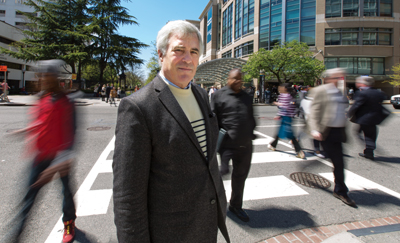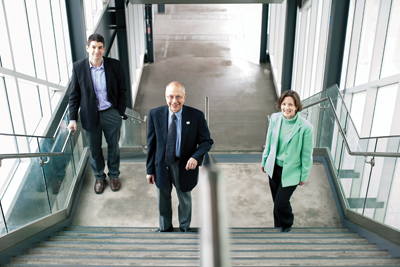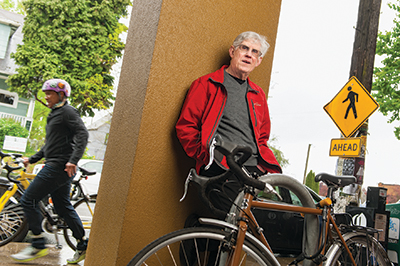The Return of Walkable Living
Automobility makes way for a feet-first approach to transit

Chris Leinberger ’72 is in the thick of the walkable urban development scene on the George Washington University campus near the Foggy Bottom metro station. Photo by Laurence Kesterson.
With 3 million residents, Minneapolis–St. Paul has the 15th largest metro area in the United States—bigger than Pittsburgh’s but smaller than Philadelphia’s. Like all metropolises, the Twin Cities have their own histories. But they also share a larger urban history of the country, a history that for most of the last century was defined by the automobile-led push from city centers into the suburbs.
“In general, we followed the same arc as other American cities that saw a lot of suburban development,” says Mark VanderSchaaf ’72, director of regional planning at the Metropolitan Council, which provides regionwide infrastructure for the Twin Cities’ metro area.
Though he recalls being interested in city planning from eighth grade on, VanderSchaaf took a circuitous path to his profession. The Swarthmore history major pursued a doctorate in religion at the University of Iowa and taught college for four years.
“The courses I was teaching were interdisciplinary, and I learned to focus on cities as the places where various historical and cultural trends were taking place,” he says. That inspired VanderSchaaf to pursue a master’s degree in city planning at the University of Wisconsin, then spend 17 years as a city planner for St. Paul, before joining the Metropolitan Council. He’s directed the agency’s planning function since 2004. In that decade, the Twin Cities and their suburbs have begun to push back against the primacy of automobile transportation, most notably with an ongoing light-rail project that recalls an earlier era of walkable living. This push, too, is part of a nationwide trend.
Perhaps trend is the wrong word. “I think this is a structural change, not cyclical,” says Chris Leinberger ’72, the Charles Bendit Distinguished Scholar and Research Professor at the George Washington School of Business and president of LOCUS, a coalition of real-estate developers who advocate for sustainable, walkable urban development. In the course of human history, sprawl is an anomaly.
“For 6,000 years, we only built walkable, urban places,” Leinberger says. “Even with railroad suburbs—take the Main Line or Media Local suburbs of Philadelphia, for example—once you got to them, you walked from the train station.” But the 20th century saw the rise of the automobile and, particularly in the United States, an economy that was largely tied to that rise. Beginning in the 1920s and accelerating after World War II, “all we built were drivable suburban areas, and we abandoned our center cities,” Leinberger says. “But for the past decade or so, that’s changed. People are moving back into the cities and also transforming the suburbs into walkable communities. And this isn’t slowing down, it’s accelerating.”
THE RISE OF AUTOMOBILITY
Many of the cities we associate today with sprawl were built with other forms of transportation in mind. Atlanta began as a railroad town, the transit hub of the Southeast. In the early 1800s, city residents relied on streetcars and trolley buses. But Atlanta stopped running streetcars in 1949, and trolley buses ceased operations in 1963. Greater Los Angeles’ streetcar system (Pacific Electric’s “Red Cars”) once connected Pasadena, downtown Los Angeles, San Bernardino, Long Beach, and other surrounding cities. “In 1945, it was the most expansive passenger-rail service in the world,” Leinberger says. The Red Car line was longer than New York City’s subway system. But in 1961, Red Car operations ceased.
What happened? A common shorthand explanation is that when in Europe fighting the Nazis, Gen. Dwight Eisenhower, was impressed by Germany’s Autobahn system. In 1956, President Eisenhower directed federal dollars toward the highway system—at rail’s expense.
Tellingly, the world’s oldest sport utility in mass production, which Chevrolet unveiled in 1935, is called the Suburban. Highway construction was heavily subsidized. And zoning laws were changed to give primacy to the car nearly everywhere outside city centers. (Even in the most walkable of urban areas, such as Manhattan, city planners like Robert Moses did their best to promote the automobile.)
“For new development, we made walkable urban spaces illegal to build in almost every jurisdiction,” Leinberger says. “Instead, we saw a super-low-density development pattern taking advantage of the country’s abundance of land. This was drivable suburban development, where you separate residential from commercial, where you put universities and hospitals—‘eds and meds’—somewhere else.” Automobiles made nonwalkable suburbia possible.
To be sure, the automobile also influenced life outside the United States. But European cities didn’t experience a similar degree of sprawl. (Metro Washington, D.C., has one-eighth the population density of metro Paris.) And sprawl was reinforced in the United States by desegregation and “white flight.” “The rise of drivable suburban development allowed people to self-segregate,” Leinberger says.
PEDESTRIANISM MAKES A COMEBACK
Drivable development had its critics. In The City in History, published in 1961, the historian Lewis Mumford pilloried suburbia as “a multitude of uniform, unidentifiable houses, lined up inflexibly, at uniform distances, on uniform roads, in a treeless communal waste, inhabited by people of the same class, the same income, the same age group, witnessing the same television performances, eating the same tasteless prefabricated foods, from the same freezers. …” In The Death and Life of Great American Cities, published the same year, Jane Jacobs argued for mixed-use neighborhoods and pedestrianism, opposing the construction of highways to whisk commuters to suburbia. A more coordinated response came in the 1980s with the rise of the New Urbanism movement, a cross-disciplinary grouping of architects, developers, and academics, whose public manifesto states, “communities should be designed for the pedestrian and transit as well as the car.”
Several factors have contributed to the return of pedestrianism. In the 1990s, baby boomers were increasingly drawn back to cities, many of which were experiencing precipitous drops in crime. “Without crime falling, I don’t think this walkable urban era would have happened,” Leinberger says.
MAKING STRIDES AGAINST SPRAWL
Around the same time, the real-estate bubble burst, exposing the inflated values of isolated new developments and suburban McMansions. “What collapsed wasn’t the walkable urban real estate; it was the drivable, suburban fringe,” Leinberger says. “We built too much product in the wrong location.”

Three of the Twin Cities’ walkable-living advocates meet up in St. Paul’s Union Depot, where a light-rail stop was set to open this June. From left: Russell Stark ’95, Mark VanderSchaaf ’72, and Libby Starling ’92. Photo by Courtney Perry.
One would expect progressive cities like Portland, Seattle, Boston, Washington, D.C., and New York to lead the walkability movement. “In Portland, we never had the full-scale neighborhood abandonment that you saw in industrial cities such as Detroit,” says Carl Abbott ’66, a professor of urban studies and planning at Portland State University. The city is bike-friendly, has streetcars, and opened a light-rail system in the early 1980s with a new line expected to open next year. “Here, planners talk about 20-minute neighborhoods,” he says. “All your everyday needs should be within a 20-minute walk.”
Many cities have yet to follow Portland’s model. “There are metro areas that are still tied to the old industrial and extractive industries that rely almost exclusively on car travel,” Leinberger says. “Houston, Dallas, cities in Montana and South Dakota—they’re all doing fine economically, extracting minerals, and continuing to build drivable suburban development.”
But even former poster cities for sprawl have made strides. There’s been significant walkable, urban revitalization in downtown Los Angeles and along the many new light-rail corridors. “Places like downtown Pasadena and downtown Santa Monica went downhill after the 1950s,” Leinberger says. “But because they were laid out before the car’s ascendancy, they have a great grid of streets and historic buildings, and they’ve come roaring back in the last 20 years.”
The same can be said of Atlanta. “At GWU, we did an analysis of Atlanta and were shocked to find that in the real-estate cycle that began in 2009, we have seen the end of sprawl,” Leinberger says. Sixty percent of the development was taking place in just 1 percent of the land. Atlanta introduced a light-transit system and began building sidewalks on former commercial- and industrial-zoned areas.
But in Atlanta the car remains ascendant—especially when traveling between far-flung neighborhoods. There also persists a tension between urban and suburban development in the Twin Cities, says Russell Stark ’95, a St. Paul city council member and advocate for walkable living. “A lot of people are accustomed to low-density living and push back,” he says. “They say, ‘If we wanted to live a more urban lifestyle, we’d move to Chicago.’ ”
TWIN CITIES MIND THE LIGHT (RAIL)
Still, the region’s new light-rail system has allowed Stark and his allies to paint their opponents as enemies of progress. “In St. Paul, the argument that won them over was that we risk being left out of the system, with all its ancillary economic benefits,” he says.
The Twin Cities’ rail-transit system had a curious start. In the late 1990s, Minnesota’s eccentric governor and ex-professional wrestler, Jesse Ventura, had an epiphany. “He said he wanted to be able to take a ride in a train, so his leadership resolved a debate that had been going on for decades,” VanderSchaaf says. The region’s first light-rail line opened in 2004, connecting downtown Minneapolis, the Mall of America in Bloomington, and the Minneapolis-St. Paul International Airport. City planners scrambled to change zoning laws and plan for walkable development along the corridor, “but with that first line, all the preparations weren’t quite there yet,” VanderSchaaf says.
He started at the Metropolitan Council the year the region’s second light-rail line opened, and he’s been more directly involved with the planning of the rail’s second line, slated to open in June with 23 stops along 11 miles, connecting the Minneapolis and St. Paul downtowns. “This time the two cities overhauled their zoning codes in advance to allow for mixed-use development, and a strong team of public, private, and nonprofit partners are already bringing a pipeline of investment into the corridor,” VanderSchaaf says.
The Twin Cities’ light-rail system is designed more for urban use than for suburban commuters, says Libby Starling ’92, manager of regional policy and research at the Metropolitan Council. “There are bus routes, but for a lot of people there’s a bias against using buses; [instead] they’ll ride on a train,” she says. “Plus, light rail is more appealing for developers. A bus route can change, so why would a developer invest in a certain area along a bus route? The rail hubs are meant to be more permanent.”
Light-rail projects sprouting across the country arrive in conjunction with another trend, which planners call suburban retrofit. “We haven’t built a suburban shopping mall in this country in the past year,” Leinberger says. Instead, malls are being bulldozed to make way for mixed-use streets. “You see sidewalks being built on streets that previously had only accommodated cars,” Abbott adds. “In other areas you see cul-de-sacs being cut open to accommodate pedestrian traffic.”
EXPENDING POSITIVE ENERGY

Carl Abbott ’66 is right at home in bike-friendly, walkable Portland, Ore., a veritable progressive person’s paradise. Photo by Steve Hambuchen.
The newfound allure of the city and city-style pedestrian living in the suburbs has environmental and health benefits. “We have no idea when we’re going to reach peak oil, but driving your car, especially if you’re just a single commuter, isn’t an efficient use of energy,” Abbott says. “And if your daily life includes a lot of walking, you’re obviously going to be healthier than someone who drives everywhere and doesn’t exercise.”
Starling points out an added benefit: Relying on public transportation allows time for multitasking. “You can work on your computer or text, which you shouldn’t be doing if you’re driving a car.”
But a return to pedestrianism comes with an unfortunate byproduct: Skyrocketing property values have forced many poorer and even middle-class residents from their neighborhoods. Witness the protests in San Francisco against the technocrats. In New York, much has been made of director Spike Lee’s recent public screed against gentrification. The fears of civic-minded planners, Leinberger says, were summed up in “The Plan,” a 1998 multi-panel cartoon by editorial cartoonist Tom Toles. The stages of development are delineated: Whites live in cities; minorities move into cities; whites flee cities to suburbs; whites move into second-ring suburbs; minorities move into first-ring suburbs; whites move back into cities. In the final panel, the whites collectively announce, “It worked.”
Many cities, such as Philadelphia, Boston, and Washington, have started or are planning initiatives “centered on reducing or freezing property taxes for [working- and lower-middle-class homeowners] in an effort to promote neighborhood stability, preserve character, and provide a dividend of sorts to those who have stayed through years of high crime, population loss, and declining property values,” The New York Times recently reported. Still, such measures, which themselves are small, don’t account for low-income renters, who find themselves pushed out unless they can avail themselves of rent-controlled apartments or subsidized housing.
“What you’re seeing increasingly are suburban low-income, often immigrant communities in the inner-ring suburbs that aren’t necessarily walkable or well connected by public transit,” Abbott says.
“The great challenge of this new era of walkable urban development is affordable housing,” Leinberger says. But perhaps if the era of new suburban, drivable development is in fact over, as he believes, then this problem will someday end. Walkable living will be available for all, just as it was in the not-too-distant past.
 Email This Page
Email This Page